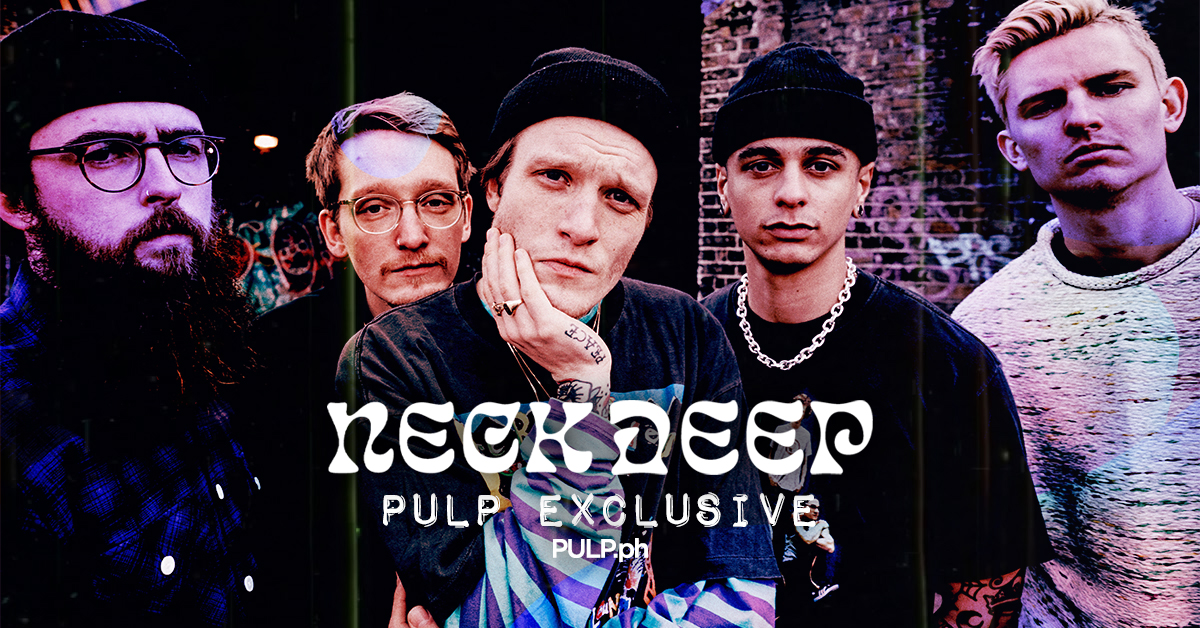
“IF IT DOESN’T SCARE US, WHAT’S THE POINT?” — NECK DEEP’S SEB BARLOW ON THE MAKING OF ‘ALL DISTORTIONS ARE INTENTIONAL’
Words and Interview by Nic Angeles | Photo by Steve Gullick, courtesy of Hopeless Records Asia
Sonder—the profound realization that each random passerby is living a life as vivid and complex as your own, with their own ambitions and worries. It’s an awareness that what’s outside is so much bigger than yourself, with every other person having experiences and entire worlds of their own. It’s knowing that you are but an observer, just as others are to every other soul they might encounter on this earth.
The word comes to life as the NECK DEEP unit journeys on to Sonderland—a sort of wonderland except, well, it’s sonderland. It’s where we meet Jet and Alice and where we encounter “lowlifes” and “normies.” For frontman Ben Barlow, sonder is acknowledging that you may just be an extra in someone else’s story. “It’s that strange existential realization that you are not the entire world… Everyone around you feels and lives the same way that you do.”
Sonderland is a place—a well-thought out “concept” around which All Distortions Are Intentional, Neck Deep’s highly anticipated fourth album, revolves. Arriving about three years since their third album The Peace and The Panic (2017), the forthcoming record promises to be a journey of self-discovery and personal expression, and we’ve found it to have had an execution that’s as complex as it is simply creative.
All Distortions Are Intentional marks a point where Neck Deep have kinda achieved a mastery of the “scene” they’ve long represented, evolving to their next stage as a bigger and bolder band. What follows is an insightful conversation with the band’s new bassist Seb Barlow, Ben’s brother and a long-time Neck Deep collaborator finally turned official member. As someone who has seen how the band grew ever since Day 1 (the band began in his bedroom, after all), he is perhaps the best person to tell the story of how Sonderland came to be, and how All Distortions Are Intentional came to life.
He goes in-depth, talking about the difference of calling the record a conceptual album rather than a concept album; how the character of Jet is an exaggerated reflection of Ben; how important it is to be honest and try to push oneself to see just where one’s sound could expand to; and how him being officially part of the Neck Deep unit had been a long time coming. Read on:
PULP: First and foremost, was there a specific place or influence from which the conception of Sonderland came from? Or something like an “a-ha!” moment when it first came to mind?
SEB: The real “a-ha” moment came from “Lowlife”, when Ben realised he could write about a character (Jet) rather than himself. We knew we wanted to make this album different, whilst still keeping the Neck Deep DNA at its core, so we were all listening to a lot of older influences like The Beatles, Third Eye Blind, Smashing Pumpkins, and a bit of Foo Fighters. But the real influence came when Ben realised he could tell a story through someone else. I kind of acted as a built of a mask and self-defensive mechanism, allowing him to really immerse himself in the lyrics without being worried about being “too personal.” Sonderland is essentially Jet’s personal world, in which he felt like he is a stranger looking out of a window, watching everyone else’s lives pass him by, whilst realising they are the stars of their own movie and everyone else is just an extra.
PULP: Jet and Alice, lowlifes and normies—the music video for “Lowlife” really helped somehow characterize them. Would you say that these are characters that were based on some people in real life? Or were they created to fit that concept?
SEB: Jet is essentially an exaggerated version of Ben. As previously mentioned, by wearing a mask, he allowed himself to feel comfortable revealing more personal details about his own life without worrying about saying too much. I remember early on in the writing process of this record, or it may have been years ago or in passing conversation about music, I mentioned to Ben to be as honest as possible, because as soon as you start thinking, “Hmm, maybe that’s too real,” and pull it back, is when you dilute the art and it becomes less meaningful and potent. Alice is Jet’s love interest who is loosely based on Ben’s girlfriend, Niamh. The whole album tells the story of Jet feeling lost, meeting Alice, falling in love, the highs and lows, and the conclusion of what life is about in his eyes.
“Be as honest as possible, because as soon as you start thinking, ‘Hmm, maybe that’s too real,’ and pull it back, is when you dilute the art and it becomes less meaningful and potent.” — Seb Barlow
PULP: Watching the video, there’s something very 90s about it in some way. But hearing just the first song, it’s tough to tell whether this sort of vibe is just on an aesthetic level. Is this something that the band is really going for? Why or why not?
SEB: We are definitely going for that style and era in our sound and aesthetic. As we’ve gotten older, I think we have gone back in time and started to revisit more classic albums and artists. I don’t want to speak for everyone, but a lot of new music doesn’t particularly excite me, so we wanted to garner inspiration from elsewhere. We wanted to experience music that was considered classic or genre-defining, and understand why alternative music is where it is at today. Sort of reverse engineer the feelings that those albums give people and try and understand why. But on the other hand, it wasn’t this conscious and really thought out process of “we need to sound like this band and that band and it needs to sound more 90s.” As always, we are just writing music that we would enjoy listening to and that we get excited about.
PULP: At first, the record was expected or seen to be a concept album. Has the band always found it easier to write songs around a concept or idea, or is it always more of individual songs somehow fitting together in such a way that there’s a common thread to them?
SEB: I think Ben has always written stories and lyrics around a central “character” but All Distortions Are intentional is the first time he’s written a linear story. We have described the album as a “conceptual album” rather than a “CONCEPT album.” If you want to look for the underlying story and meaning, you can find it, but you don’t have to. If you just want to listen to the record, you can, you don’t need to know the story and the concept behind it. But as I previously mentioned, Ben definitely found it easier to write once he realised he was telling a story. He knew the start, he knew the end, so he just needed to fill in the gaps in the middle.
PULP: Characters aside, from what sort of headspace was “Lowlife” coming from? Where did the song come from lyrically?
SEB: A place of saying “fuck you” to the real world. An angsty, adolescent headspace where you feel like everyone else is normal and you’re a weirdo that doesn’t fit in. ‘Normie’ is UK slang for a ‘normal’ or ‘regular’ person, someone who conforms to society’s standards and rules and takes no risks or interest in things outside of the defined norm. So the song is kinda attacking that regular person vs perceived weirdo dynamic.
PULP: ALL DISTORTIONS ARE INTENTIONAL. Is there a story to the album title?
SEB: There is totally a story to the album title! For a while, the only album placeholder name we had was “Welcome To Sonderland” but a few people thought it sounded a little too close to “Sunderland,” which is a town in the north of England, so we kind of wanted to avoid that… On this record, we also wanted to avoid any kind of whimsical or fantasy-esque titles. We have all matured past that point. We wanted this record to show us in a different light and we didn’t feel that album title reflected us or the sound. “All Distortions Are Intentional” actually came from the artist who did the cover art, Tom Noon. We were looking through his portfolio and he entitled one of his pieces “all distortions are intentional,” so we asked if we could use it and he said yes. We felt that ADAI immediately felt better. It summed up our evolution sonically, it summed up the nature of reality, and it summed up the narrative, which runs throughout the album.
PULP: For album number four, what’s something new in the writing or recording process? Have there been any departures from how you did the first three Neck Deep albums?
SEB: This album was totally different from any other record we’ve done in regards to the actual production process. For Wishful Thinking, we did everything at my parents’ house in my home studio; Life’s Not Out To Get You was done in Florida, where only two or three people were in the studio at any given time and we had set hours as to when we could record and create; The Peace and the Panic was the same but in LA. The distractions and free time were a total juxtaposition from the studio and I think it fucked with people’s heads a little bit. Nobody wanted to do the “you can only be creative between this time and this time” again, so that’s why we went to Monnow Valley for seven weeks. It’s a residential studio in the middle of absolute nowhere, down in South Wales, and we could be completely immersed in making the record 24/7. There is a huge 10-bedroom house attached to the studio. We would usually start around 11 in the morning and go to midnight-1am most nights, then either play pool or hang out. It was truly amazing and one of the best experiences I think any of us have ever had in our lives. There was no phone signal, no Wi-Fi, and no drama. Completely cut off from the outside world. Every other record we’ve done have all been done in very small, almost “project” studios. Of course, they were super professional and had everything you need to make a record. But we wanted to make a record like they used to 20-30 years ago, which is another reason we chose Monnow Valley. Oasis, Black Sabbath, and The Stone Roses have all recorded there. It has a huge control room, with an amazing, vintage Neve desk and more outboard gear than we knew what to do with, and the live room is incredibly beautiful. It’s probably one of the only live rooms in the world that has three enormous windows at one end where you can see out into fields, forests and rivers.
In terms of the writing process, it was much the same as it always is. We demo and write everything out to almost 100% before we go to the studio to record it for real. One thing we tried differently this time was to go and try some writing sessions in LA and New York, as our label wanted us to at least try it. It was a complete disaster and we hated it. We had two sessions in total and we canceled the other 4-7 sessions we had booked and just wrote on our own as we always do in our hotel room. One of the sessions was actually cool though. We spent a couple of days with Zak Cervini, who was really nice. Even he said at the end of the second day, “Why are you guys out here writing with people? You don’t need to,” to which we replied “Yeah, we just canceled every other session we had booked.” (laughs)
However, one of the biggest cornerstones we always had at the forefront of our mind when we were writing was, “If it doesn’t scare us, what’s the point?” We wanted to push ourselves, make ourselves uncomfortable and really see where we could expand our sound to, whilst still keeping in mind what our fans expect from us. It’s a fine balance between doing what you want to do, whilst also respecting our fans and what got us to where we are in the first place.
PULP: The studio you recorded in was quite a legendary one, some might say. What were some of the most vivid memories you have of working on AIAD in there?
SEB: For sure! Honestly, the whole experience was incredible for everyone. We felt united. We felt like we were all on the same page (most of the time) and we felt like were making important, inspiring, and meaningful art. Some vivid memories include ordering Sage from Amazon Prime to cleanse the studio of negative or nasty spirits, hearing songs like “When You Know,” “Little Dove,” and “Quarry” come to life, playing pool every night, finishing a song, mixing it in another room and then listening back together, listening through the whole album every night on the last week. Like I say, every moment was memorable.
I Revolve fun fact. It was one of the very first songs written for ADAI! We recorded a version of it with @matt_squire during the She’s A God sessions in May 2019 and knew we’d hit on some album 4 magic
— Neck Deep (@NeckDeepUK) July 16, 2020
PULP: What was the band’s relationship with Matt Squire like throughout your creative process? What influence did he have on the record?
SEB: Matt Squire was absolutely the best producer we could have asked for. He was the first person we met when we went over to do some writing sessions in LA and NY and within 15 mins we knew he was who we wanted to do the record. Maybe that was the reason the rest of the trip sucked? Because we were comparing everyone to Squire and nobody came close. We just immediately got on and hit it off. Production and his discography aside, we could see ourselves spending 12 hours a day in a studio with him, and that was very very important to us. Neck Deep is quite a closed, small circle of friends and we can find it hard to let people in. So when we know, we know, and Squire was immediately part of the crew and a good friend. I think the biggest influence Squire had on the record is that he knew exactly what we wanted to do and what we needed to do, so there was never an idea too silly or weird and he never said no. Any suggestion was immediately met with “Fuck yeah, let’s try it.” That was another huge part of recording in a residential studio, 24/7, was that all the instruments, amps, gear, and microphones were set up constantly, so it was super easy to try new things, change things and generally be super creative without being slowed down. Squire works insanely fast and wants to capture a moment and a feeling. He kept the morale of everybody up all the time. I don’t think I ever saw him bored, down, angry or moody. He was constantly happy, encouraging and inspiring.
PULP: Can you tell us about the moment you sort of officially joined the band? Did this happen during the making of the album or afterward? And what’s the dynamic of the band like now with this new lineup?
SEB: It’s sort of been a long time coming. I’ve been a part of ND behind the scenes with pretty much everything, since the first note we ever recorded. The band started in my bedroom and we recorded and wrote everything in my bedroom. I just feel like the time was right. I’m at a point in my life now where I feel comfortable being away from home and touring the world. I’ve struggled with anxiety and mild depression for a long long time, but I’ve been working on it pretty hard for the last 12-18 months and I feel like I’m in a great space mentally. The band has actually asked me about it a few times over the years, semi-joking, as I’ve always made it quite clear that I wasn’t ready, but this time, I was. I think because I’ve always been on the sidelines, every member respects my opinion and values my input. They know that ND has always been the centre of my world and I have nothing but the purest intentions for the band. I’m essentially the band’s number 1 fan. The other thing is (and this might sound like I’m just saying it for PR, but I’m truly not) that I felt very connected and very passionate about this album. It feels special and it resonates with me on a multitude of levels. I’m incredibly proud of what we have created and I can’t wait to see where it takes us. PULP
Pre-order All Distortions Are Intentional here.
—
Special thanks to Hopeless Records Asia







